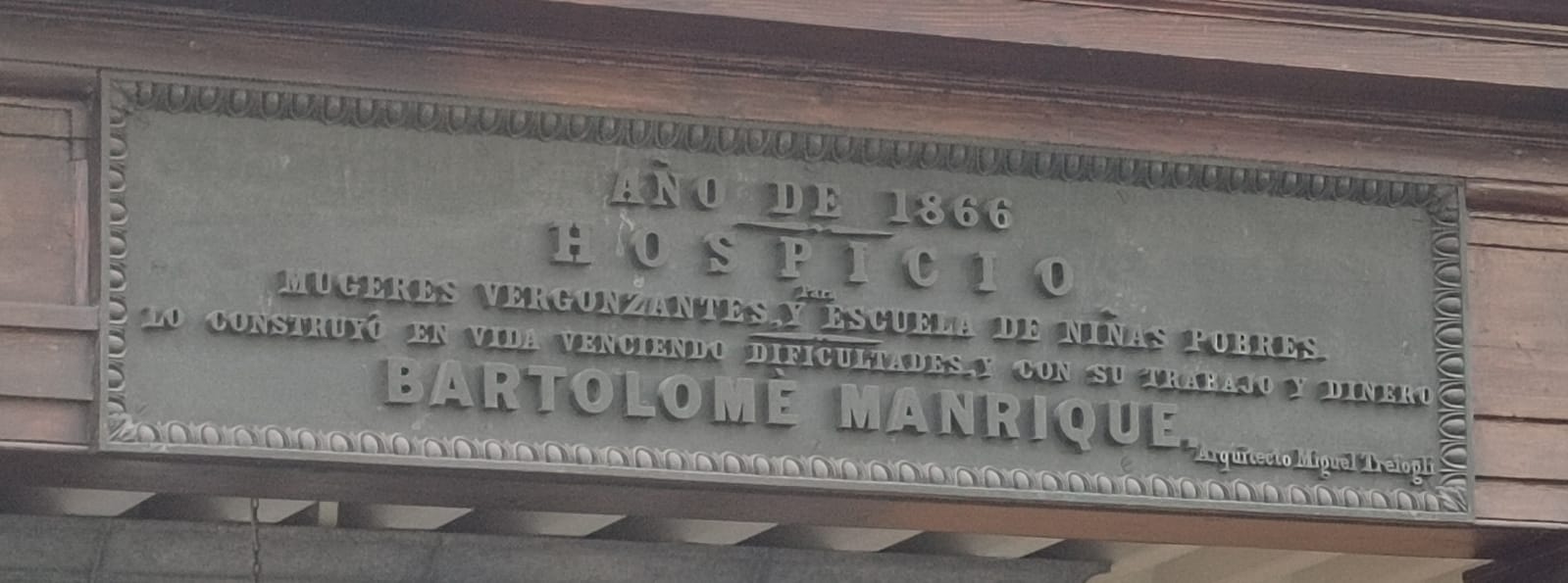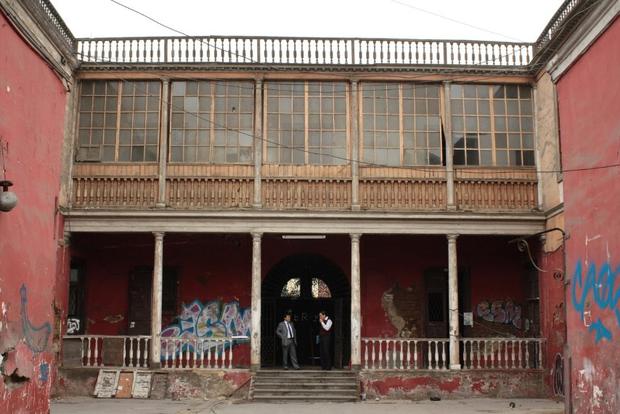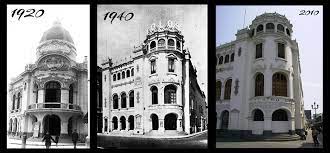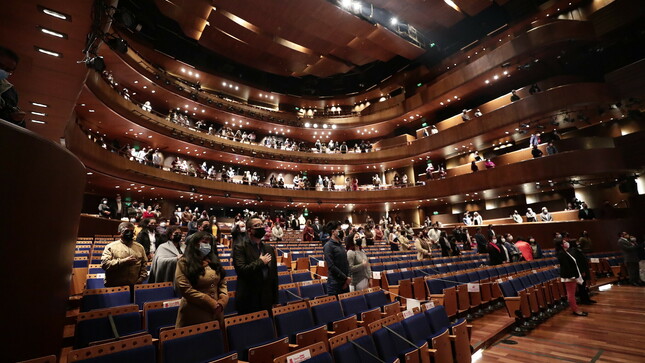[ENG] buildings with history / [ESP] Edificios con historia
[ENG]
It is a pleasure to be able to participate with you, I hope to be up to the task and from now on I am very grateful to @marcosmilano71 and @manuelmilano since thanks to their invitation I can participate with you and show my steps, I hope the post is to everyone's liking.
[ESP]
Es un gusto poder participar con ustedes, espero poder estar a la altura y desde ya muy agradecida con @marcosmilano71 y @manuelmilano ya que gracias a su invitación puedo participar con ustedes y mostrar parte mis pasos, espero el post sea del agrado de todos.

.jpeg)
.jpeg)
.jpg)

In the walks that I usually take through the center I usually enjoy its history, its beautiful buildings and here I share some.
Hospice Bartolome Manrique
For Shameful Women and School for Poor Girls.
Created in 1866 with the collaboration of the Chilean philanthropist Bartolomé Manrique, considered a neoclassical style building located in Plaza Francia.
Its function was to house wealthy women who fell into disgrace or poverty and it also housed poor girls.
After the war many wealthy women lost their husbands and we have to remember that in those years the woman depended on the man in many aspects and by losing her husband that economic status was also lost.
In this way, the place allowed these women to live with dignity and since many of these women had had an education, they were asked to share their knowledge by training girls from the poorest sectors of the city so that the girls could have access to knowledge.
With the passage of time came the war with Chile and the building ceased to function, abandoning the importance for which it was created.
As time went by and as Lima changed, the building was neglected and abandoned, being occupied by people with bad lives, and with that, the building went into serious deterioration, losing the value it initially obtained.
In 2014, the municipality of Lima recovered the property by executing a recovery plan respecting its architecture and surroundings where the Ignacio Merino art gallery currently operates on the second level.
Currently, many of the emblematic buildings in the center of Lima are undergoing a restoration process, which makes us very happy, since these buildings with their structures tell part of our history.
En las caminatas que suelo realizar por el centro suelo disfrutar de su historia, de sus bellas edificaciones y acá les comparto algunas.
Hospicio Bartolomé Manrique
Para Mujeres vergonzantes y escuela de niñas pobres.
Creado en 1866 con la colaboración del filántropo chileno Bartolomé Manrique, considerado un edificio de estilo neoclásico ubicado en plaza Francia.
Su función era albergar a mujeres acaudaladas que caían en desgracia o pobreza y también albergaba a niñas pobres.
Luego de la guerra muchas mujeres acaudaladas perdieron a sus esposos y tenemos que recordar que en aquellos años la mujer dependía del hombre en muchos aspectos y al perder a sus esposos también se perdía ese estatus económico.
De esa manera el lugar permitía a dichas mujeres vivir con dignidad y como muchas de esas mujeres habían tenido educación se les pedía compartir sus conocimientos formando a niñas de los sectores más pobres de la ciudad para que así las niñas puedan tener acceso a conocimiento.
Con el paso del tiempo llego la guerra con chile y el edificio dejo de funcionar dejando en el abandono la importancia por la que fue creado.
Ya en el transcurrir del tiempo y conforme fue cambiando Lima, la edificación fue descuidada y dejada en el abandono siendo ocupada por personas de mal vivir y con eso la edificación paso a un fuerte deterioro perdiendo el valor que obtuvo inicialmente.
En el año 2014 la municipalidad de lima recupera el inmueble ejecutando un plan de recuperación respetando su arquitectura y entorno donde actualmente funciona en el segundo nivel la pinacoteca Ignacio Merino.
Actualmente muchos de los edificios emblemáticos del centro de lima estas en un proceso de restauración el cual nos alegra mucho ya que dichos edificios con sus estructuras cuentan parte de nuestra historia.
.jpeg)


COLON THEATER
The Teatro Colón was the theater frequented by the Lima aristocracy of the time. During its first years of existence, mainly due to its beauty and its acoustic conditions, it was the favorite of many comedy companies that did not need much for their performances on a very large stage, a true familiarity between actors and spectators was felt.
The first known owner of the land was Mr. José Manuel Alejo de Hurtado around 1861.
then this land passed through many owners until it was finally sold by Don Francisco de Oliva to the Company of Theaters and Cinemas, in the year 1911.
In that same year, the French architect Claude Sahut - the same architect of important buildings in Lima - was commissioned
The Teatro Colón was inaugurated in 1914, with the Fabregas company, with the play “Los Fantoches”, in charge of initiating the history of the Teatro Colón.
Around 1921, the Teatro Colón was one of the few theaters that only presented theater, but later the projection of cinematographic films was sporadically allowed.
In 1927 the Teatro Colón decided to become a permanent projection room for movies, the movies were mostly comedy, police, gangsters.
At the end of 1929, the film "El Capitán Calaveron" was presented at the Teatro Colón, which was the first sound film released in Lima.
In the year 1936, the engineer Alejandro Garland was entrusted with the remodeling of the Theater, which would introduce substantial changes to the original creation of the building.
The current structure of the Colón theater corresponds to the changes made at that time.
These changes were given mainly to adapt the use of the Theater as a Cinematographic Room, in addition to adapting its structure to the Architectural Complex formed by the other existing buildings in the Plaza, which were later built to the Teatro Colón, in a few words the theater had to be aligned to the rest of buildings.
In the 1970s, the Teatro Colón was nationalized by the dictatorship of General Velasco, but even so, the CIA Company of Theaters and Cinemas appears as its owner.
It is from then on that picaresque films begin to be shown, such as those performed by Porcel and Olmedo.
At the end of the 1970s, the total decline of the Theater began, in the 1980s and 1990s, the already denigrated image of the Theater deteriorated even more with the projection of films for adults and in the year 2000 the situation became unsustainable for the authorities, and made the municipality close the premises.
The Metropolitan Municipality of Lima decided to carry out the definitive walling of its doors and facilities.
In 2004 the Teatro Colón proceeded to be auctioned by the Metropolitan Municipality of Lima, and acquired by the current Directorate of the Theater.
In 2005, the NGO Teatro Colón Cultural Project was established, with the goal of rehabilitating the completely deteriorated structure of the Theater in order to turn it back into a building full of culture, with social commitment and worthy of national pride.
TEATRO COLÓN
El Teatro Colón fue el Teatro frecuentado por la Aristocracia limeña de la época. Durante sus primeros años de existencia principalmente a su belleza y sus condiciones acústicas, fue el preferido de muchas compañías de comedias que no necesitaban de mucho para sus representaciones de un escenario muy grande, se sentía una verdadera familiaridad entre actores y espectadores.
El primer propietario del terreno que se tiene conocimiento fue el señor José Manuel Alejo de Hurtado hacia el año 1861.
luego éste terreno pasa por muchos propietarios hasta ser finalmente vendido por Don Francisco de Oliva a la Empresa de Teatros y Cinemas, en el año 1911.
En ése mismo año se encarga al arquitecto francés Claude Sahut -el mismo arquitecto de importantes edificaciones de lima
El Teatro Colón se inaugura en el año 1914, siendo la compañía Fabregas con la obra «Los Fantoches» la encargada de iniciar la historia del Teatro Colón.
Hacia 1921, el Teatro Colón era una de las pocas salas de teatro que sólo presentaba teatro, pero luego se permitió esporádicamente la proyección de películas cinematográficas.
En el año 1927 el Teatro Colón decide transformarse en una Sala de Proyección permanente para películas de cine, las películas eran en su mayoría del estilo comedia, policial, gangsters.
A finales del año 1929 en el Teatro Colón se presenta la película "El Capitán Calaveron", la cual fue la primera película sonora estrenada en Lima.
En el año 1936, se encarga al ingeniero Alejandro Garland, la remodelación del Teatro, la que introducirá sustanciales cambios a la creación original del inmueble.
La estructura actual del teatro Colón corresponde a los cambios efectuados en esa época.
Estos cambios fueron dados principalmente para adaptar el uso del Teatro como Sala Cinematográfica, además de adecuar su estructura al Conjunto Arquitectónico formado por los demás edificios existentes en la Plaza los cuales fueron construidos posteriormente al Teatro Colón, en pocas palabras el teatro tenía que alinearse al resto de edificaciones.
En los 70 el Teatro Colón es estatizado por la dictadura del General Velasco, pero aun así figura como propietario la CIA Empresa de Teatros y Cinemas.
Es a partir de ese entonces que se comienza a proyectar películas del tipo picaresco, como las actuadas por Porcel y Olmedo.
A finales de los años 70 comienza la decadencia total del Teatro, en los años 80 y 90, la ya denigrada imagen del Teatro se ve deteriorada aún más con la proyección de películas para adultos y en el año 2000 la situación se tornó insostenible para las autoridades, e hizo que el municipio clausurase el local.
La Municipalidad Metropolitana de Lima decidió realizar el tapiado definitivo de sus puertas e instalaciones.
En el año 2004 el Teatro Colón procedió a ser subastado por la Municipalidad Metropolitana de Lima, y adquirido por la actual Dirección del Teatro.
En el 2005 se constituye la ONG Proyecto Cultural Teatro Colón, la cual tiene como meta rehabilitar la estructura totalmente deteriorada del Teatro para poder convertirlo nuevamente en un edificio lleno de cultura, con compromiso social y merecedor del orgullo nacional.
Hello @nell2022 I greet you with respect and affection from the Bolivarian Republic of Venezuela. Welcome to our wonderful community Architecture+Design Thank you very much for naming me and my son as motivators, Thank you. With much respect, I suggest that you accompany your interesting historical review with more architectural details of the buildings that you show us, we also want to see more photographs. You are an excellent photographer and I know that your images will be liked, for that reason I invite you to show us more of your work. For the rest, I reiterate the Welcome and thanks. Receive a strong and warm spiritual hug full of blessings, positive energy and lots of light.
I am very grateful for your words and yes, I will have something more prepared in terms of photographic files to be able to share with you, currently many of the emblematic buildings of Lima are undergoing a restoration process and for this reason they are closed to civilian personnel. But as soon as I have access I can show everything in its entirety.
Thank you.
muy agradecida con sus palabras y si, tendré algo más preparado en cuestión de archivos fotográficos para poder compartir con ustedes, actualmente muchos de los edificios emblemáticos de lima están pasando por un proceso de restauración y por dicho motivo se encuentran cerrados para el personal civil. Pero apenas tenga acceso podre mostrar todo en su totalidad.
gracias.
Congratulations @nell2022! We're delighted to specially curate your awesome publication and award it RUNNER-UP in Architecture Brew #67. More power!
Thank you for subscribing to Architecture+Design, an OCD incubated community on the Hive Blockchain.